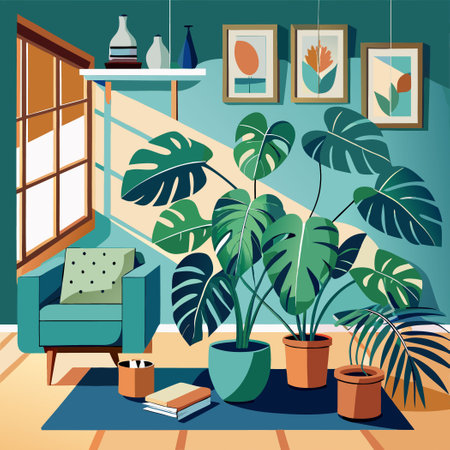Introduction to Kid & Pet Safe Indoor Plants in India
In every Indian home, the presence of greenery is more than just an aesthetic choice—it’s a celebration of life, tradition, and well-being. As our living spaces become more vibrant and family-centric, the need to ensure safety for our little ones and beloved pets is paramount. Choosing indoor plants that are non-toxic and safe for kids and pets is not merely a trend; it is a thoughtful approach rooted in care and responsibility. Indian households often blend generations under one roof, with playful children and curious furry companions sharing space. Amidst this beautiful chaos, selecting the right indoor plants becomes crucial to maintain harmony and health. With traditional courtyards or compact urban apartments, our homes reflect a unique blend of culture and modernity. The lush greens we choose must align with both our aesthetic preferences and practical needs—balancing beauty, air purification, and above all, safety. Let us delve into the importance of choosing kid- and pet-safe indoor plants that suit Indian lifestyles while fostering a nurturing environment for every member of the family.
Popular Safe Indoor Plants for Indian Households
When it comes to choosing indoor plants that are both beautiful and safe for your loved ones, Indian households have several excellent options. Whether you are living in a cozy Mumbai apartment or a spacious Delhi bungalow, these plants blend seamlessly with local aesthetics and daily routines. Let’s explore some of the most popular and easily available indoor plants across India that pose no threat to curious children or playful pets.
Areca Palm (Dypsis lutescens)
A staple in many Indian homes, the Areca Palm is celebrated for its lush, feathery fronds and air-purifying qualities. Not only does it thrive in indirect sunlight—a common feature in urban Indian homes—but it is also non-toxic to both kids and pets. This elegant plant adds a tropical vibe to your interiors without any safety concerns.
Money Plant (Epipremnum aureum)
The Money Plant, fondly known as “Pothos” or “Devil’s Ivy,” holds a special place in Indian culture for its association with good fortune and prosperity. It is incredibly easy to grow, often seen trailing from hanging pots or glass bottles filled with water. While some varieties can be mildly irritating if ingested, the classic Indian Money Plant (Epipremnum aureum) is generally considered safe when kept out of direct reach—making it a practical choice for families with young children and pets.
Bamboo Palm (Chamaedorea seifrizii)
The Bamboo Palm brings soothing green vibes and a hint of Zen to any living space. Known for its resilience against typical Indian weather conditions, this plant is not only visually appealing but also completely safe for your little ones and furry friends. Its ability to filter indoor air further cements its position as a favorite among health-conscious Indian families.
Comparison Table: Safe Indoor Plants for Indian Homes
| Plant Name | Key Benefits | Pet & Kid Safety | Cultural Relevance |
|---|---|---|---|
| Areca Palm | Air purification, low maintenance | Completely safe | Popular in modern & traditional decor |
| Money Plant | Easy propagation, prosperity symbol | Generally safe (mild irritation if chewed) | Auspicious plant in Indian households |
| Bamboo Palm | Humidity control, air filtering | Completely safe | Suits minimalist & contemporary styles |
By selecting these widely-loved indoor plants, you can create a stylish, vibrant home environment that respects both family well-being and cherished Indian traditions. Each plant not only enhances your living spaces but also ensures peace of mind—making them perfect companions for every Indian home.

3. Benefits of Bringing Greenery Indoors
Bringing indoor plants into Indian homes is more than just a décor trend—it’s deeply rooted in our culture and wellness practices. Greenery indoors offers a beautiful blend of physical, mental, and spiritual benefits, perfectly aligned with the values of Indian families who prioritise health, harmony, and tradition.
Wellness for Mind & Body
Many indoor plants safe for kids and pets, like Areca Palm or Money Plant, help purify the air by removing toxins such as formaldehyde and benzene—common in urban Indian homes due to pollution. Studies have shown these plants can improve air quality, reduce stress levels, and even boost focus—a boon for our busy households with children preparing for exams or elders seeking a calm environment.
Vastu Shastra Harmony
Plants hold a special place in Vastu Shastra, the ancient Indian science of architecture. According to vastu, keeping plants like Tulsi (Holy Basil) or Bamboo indoors invites positive energy, prosperity, and good health. These vastu-compliant choices are not just safe for your little ones and furry friends but also promote balance and peace within the home.
Cultural Connection & Everyday Rituals
In many Indian families, daily rituals include tending to houseplants—watering Tulsi after prayers or placing Aloe Vera near the kitchen. This connection nurtures mindfulness and teaches children responsibility in a gentle, engaging way. Choosing pet- and kid-safe plants ensures everyone participates safely in these beloved traditions.
Aesthetic & Emotional Upliftment
Lush green corners bring vibrancy to flats in bustling metros like Mumbai or Chennai. The refreshing sight of healthy leaves instantly uplifts moods after a long day amidst traffic and heat. With options that are non-toxic to kids and pets, families can enjoy this beauty without worry—making home truly a sanctuary.
By selecting the best indoor plants safe for kids & pets in India, you’re not only investing in a healthier environment but also honouring time-tested traditions that celebrate holistic well-being.
Care Tips for Safe Indoor Plants in Indian Climate
Bringing indoor plants into Indian homes is a joy, but it does come with unique challenges thanks to our diverse climate and urban living. Whether you’re residing in bustling Mumbai, humid Chennai, or the drier regions of Delhi, each city presents its own set of care requirements. Here’s how you can keep your kid- and pet-safe indoor plants thriving:
Understanding Sunlight Patterns
Indian homes often have windows facing different directions, and sunlight can be harsh during summers. Place sun-loving plants like Areca Palm or Spider Plant near east-facing windows for gentle morning light. For shade-loving varieties such as Money Plant or Boston Fern, a spot away from direct sunlight works best.
| Plant Name | Ideal Light | Placement Suggestion |
|---|---|---|
| Areca Palm | Bright, indirect | Near east/north window |
| Boston Fern | Low to medium | Living room corners |
| Money Plant | Indirect light | Bookshelf or balcony shade |
| Spider Plant | Filtered light | Kitchen counter/window grill |
Coping with Monsoon Humidity
The monsoon brings high humidity and less sunlight. Ensure good air circulation by keeping windows slightly open (when safe), and wipe leaves regularly to avoid fungal growth. Use well-draining pots to prevent root rot—a common issue during prolonged rains.
Quick Monsoon Care Checklist:
- Avoid overwatering—check soil moisture first.
- Add neem oil spray monthly to deter pests.
- If possible, move plants to brighter spots temporarily during cloudy days.
Navigating Urban Living Constraints
Space is premium in Indian cities. Opt for hanging planters or wall-mounted pots to save floor space. For flats with little natural light, consider low-light tolerant species and rotate your plants every fortnight for even growth.
Pro Tip:
If you are worried about pets nibbling on leaves, place your plants on high shelves or use decorative cages around pots—stylish and functional!
Caring for indoor plants in India means adapting to our unique rhythms—sunshine, monsoons, and compact homes. With thoughtful placement and mindful routines, your green friends will flourish safely alongside your family.
5. Things to Avoid: Common Poisonous Plants in India
While adding greenery to your home is delightful, it’s vital to be mindful of certain popular plants that can be dangerous for children and pets. Many of these are commonly found in Indian households and gardens due to their aesthetic appeal or cultural significance, but they pose hidden risks.
Dieffenbachia (Dumb Cane – “Supari Ka Paudha”)
This leafy plant is famous for its lush foliage, but if chewed or ingested, it can cause severe irritation and swelling in the mouth and throat. Children and pets are naturally curious, making Dieffenbachia a risky choice for family spaces.
Oleander (“Kaner”)
A familiar sight in Indian gardens and temple compounds, Oleander’s vibrant flowers hide a highly toxic nature. All parts of the plant are poisonous, even in small amounts, making it essential to keep Kaner out of reach or avoid it altogether where kids and pets play.
Peace Lily (“Shanti Ka Phool”)
Though revered for its elegant white blooms, the Peace Lily contains compounds that can cause stomach upset and oral irritation if consumed by little ones or furry friends. It’s best enjoyed as a decorative plant in spaces inaccessible to them.
Sago Palm (“Cycad”/“Sago Dana Ka Ped”)
This ornamental palm is often used in landscaping across India. Unfortunately, all parts—especially the seeds—are extremely toxic and potentially fatal to pets like dogs and cats, as well as children if accidentally ingested.
Cultural Insight: Traditional Beliefs vs Safety
In many Indian households, certain plants are believed to bring good fortune or ward off negativity. However, safety should always take precedence over tradition when children and animals are involved. For example, while Kaner is associated with auspiciousness in some rituals, its toxicity makes it unsuitable for homes with young members.
Quick Tip:
If you’re unsure about a plant’s safety, consult local nurseries or horticulturists who understand both the botanical and cultural context. Always label your indoor plants clearly to help family members identify which ones to avoid.
6. Decor Ideas: Styling Indian Homes with Safe Indoor Plants
Balcony Bliss: Urban Green Retreats
Transform your city balcony into a soothing green haven using safe indoor plants like Areca Palm, Money Plant (Pothos), or Spider Plant. Arrange them in traditional terracotta pots or colourful hand-painted planters for that quintessential Indian touch. Use vertical plant stands or macramé hangers to save floor space—perfect for apartments in Mumbai or Bengaluru! Add fairy lights and a jute rug to complete your cozy, kid- and pet-friendly retreat.
Living Room Elegance: A Breath of Freshness
Your living room is the heart of your home, and indoor plants can infuse it with warmth and vibrancy. Place lush Boston Ferns or the resilient Bamboo Palm in woven baskets beside the sofa for a natural accent. Create a stylish centrepiece using small potted Peperomia on a wooden coffee table. For a true Indian vibe, set your plants atop traditional brass urli bowls, filling them with marigold petals during festivals like Diwali or Ganesh Chaturthi.
Pooja Corner Serenity: Sacred & Safe Greens
Pooja corners are sacred spaces in Indian homes and deserve mindful styling. Choose non-toxic Tulsi (Holy Basil)—a revered and safe plant—for your altar. Enhance spiritual energy by placing Syngonium or Parlour Palm nearby, ensuring they’re out of reach from curious pets and toddlers. Use brass planters or clay pots adorned with kumkum designs for an authentic look, creating a serene backdrop for daily prayers.
Creative Touches: Personalize Your Plant Décor
Add quirky touches to your plant displays with hand-painted pots featuring Warli art or Madhubani motifs. Repurpose old copper vessels as unique planters to blend nostalgia with modern aesthetics. Group plants of different heights together for visual interest, and don’t forget to rotate them for even sunlight—a tip passed down by many Indian grandmothers!
By mindfully styling balconies, living rooms, and pooja corners with safe indoor plants, you not only elevate your home’s beauty but also create a nurturing environment for both your little ones and furry friends—celebrating Indian tradition in every leaf and pot!

